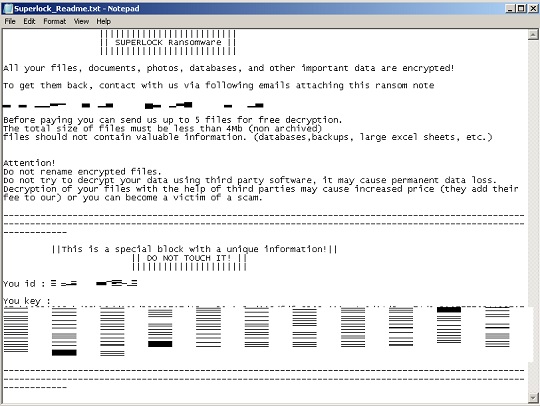Ransom.Win32.SUPERLOCK.YXEGX
Windows


Threat Type: Ransomware
Destructiveness: No
Encrypted:
In the wild: Yes
OVERVIEW
Downloaded from the Internet, Dropped by other malware
This Ransomware arrives on a system as a file dropped by other malware or as a file downloaded unknowingly by users when visiting malicious sites.
It deletes itself after execution.
It drops files as ransom note. It avoids encrypting files with the following file extensions.
TECHNICAL DETAILS
609,792 bytes
EXE
No
24 Jul 2024
Drops files, Disables AV, Encrypts files, Deletes files, Terminates processes
Arrival Details
This Ransomware arrives on a system as a file dropped by other malware or as a file downloaded unknowingly by users when visiting malicious sites.
Installation
This Ransomware drops the following files:
- {Malware File Path}\{Victim ID}
It adds the following processes:
- "%Windows%\System32\cmd.exe" /c timeout -t 5 && del "%System Root%\app\7zFM.exe"
(Note: %System Root% is the Windows root folder, where it usually is C:\ on all Windows operating system versions.)
It adds the following mutexes to ensure that only one of its copies runs at any one time:
- {Victim ID}
Process Termination
This Ransomware terminates the following services if found on the affected system:
- MSSQL
- SQLAgent
- SQLBrowser
- SQL Server CEIP
- SQL Server
- SQLTEL
- EMETRY
- SQLWriter
- MSSQLServerADHelper100
- MSSQL$ISARS
- MSSQL$MSFW
- SQLAgent$ISARS
- SQLAgent$MSFW
- SQLBrowser
- ReportServer$ISARS
- SQLWriter
- mr2kserv
- MSExchangeADTopology
- MSExchangeFBA
- MSExchangeIS
- MSExchangeSA
- ShadowProtectSvc
- SPAdminV4
- SPTraceV4
- SPUserCodeV4
- SPWriterV4SPSearch4
- MSSQLServerADHelper100
- IISADMIN
- firebirdguardiandefaultinstance
- ibmiasrw
- QBVSS
- QBPOSDBServiceV12QuickBooksDB
It terminates the following processes if found running in the affected system's memory:
- msftesql.exe
- sqlagent.exe
- sqlbrowser.exe
- sqlwriter.exe
- oracle.exe
- ocssd.exe
- dbsnmp.exe
- synctime.exe
- agntsvc.exe
- isqlplussvc.exe
- xfssvccon.exe
- sqlservr.exe
- mydesktopservice.exe
- ocautoupds.exeencsvc.exe
- firefoxconfig.exe
- sqlceip.exe
- tbirdconfig.exe
- mydesktopqos.exe
- ocomm.exemysqld.exe
- mysqld-nt.exe
- mysqld-opt.exe
- dbeng50.exe
- sqbcoreservice.exe
- excel.exe
- infopath.exe
- msaccess.exemsp
- ub.exeonenote.exe
- outlook.exepowerpnt.exe
- sqlservr.exethebat.exe
- steam.exethebat64.exe
- thunderbird.exe
- visio.exe
- winword.exe
- wordpad.exe
- QBW32.exe
- QBW64.exe
- ipython.exe
- wpython.exe
- python.exe
- dumpcap.exe
- procmon.exe
- procmon64.exe
- procexp.exe
- procexp64.exe
Adware Routine
This Ransomware deletes itself after execution.
Ransomware Routine
This Ransomware avoids encrypting files found in the following folders:
- Windows
- Program Files
- Program Files (x86)
- ProgramData
- AppData
It appends the following extension to the file name of the encrypted files:
- {Victim ID}.superlock
It drops the following file(s) as ransom note:
- {Encrypted Directory}\Superlock_Readme.txt

It avoids encrypting files with the following file extensions:
- .exe
- .dll
- .sys
- .chm
- .lnk
- .tmp
- .ini
- .inf
- .bat
- .superlock
SOLUTION
9.800
19.486.08
24 Jul 2024
19.487.00
25 Jul 2024
Step 1
Trend Micro Predictive Machine Learning detects and blocks malware at the first sign of its existence, before it executes on your system. When enabled, your Trend Micro product detects this malware under the following machine learning name:
- Troj.Win32.TRX.XXPE50FFF083
Step 2
Before doing any scans, Windows 7, Windows 8, Windows 8.1, and Windows 10 users must disable System Restore to allow full scanning of their computers.
Step 3
Note that not all files, folders, and registry keys and entries are installed on your computer during this malware's/spyware's/grayware's execution. This may be due to incomplete installation or other operating system conditions. If you do not find the same files/folders/registry information, please proceed to the next step.
Step 4
Search and delete this file
- {Malware File Path}\{Victime ID}
- {Encrypted Directory}\Superlock_Readme.txt
Step 5
Scan your computer with your Trend Micro product to delete files detected as Ransom.Win32.SUPERLOCK.YXEGX. If the detected files have already been cleaned, deleted, or quarantined by your Trend Micro product, no further step is required. You may opt to simply delete the quarantined files. Please check the following Trend Micro Support pages for more information:
Step 6
Restore encrypted files from backup.
Did this description help? Tell us how we did.

